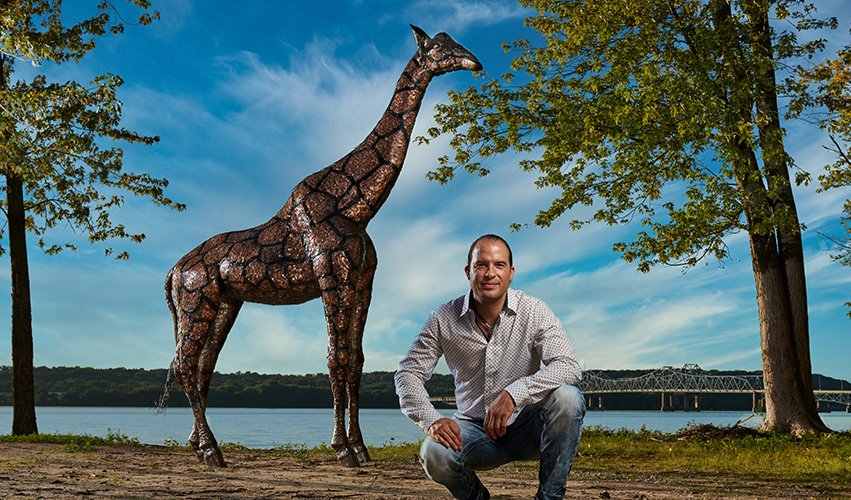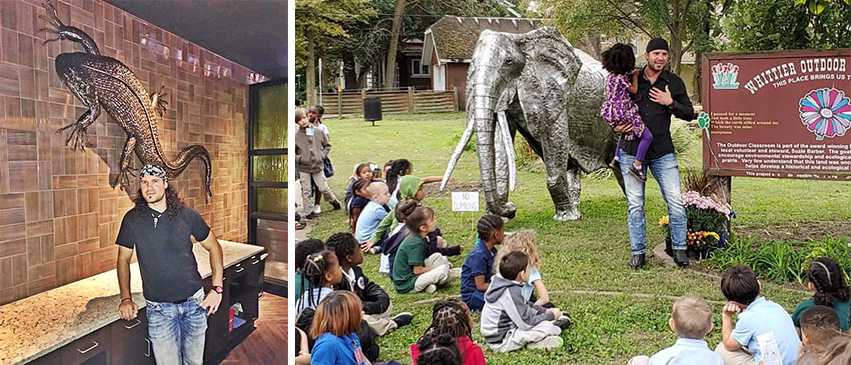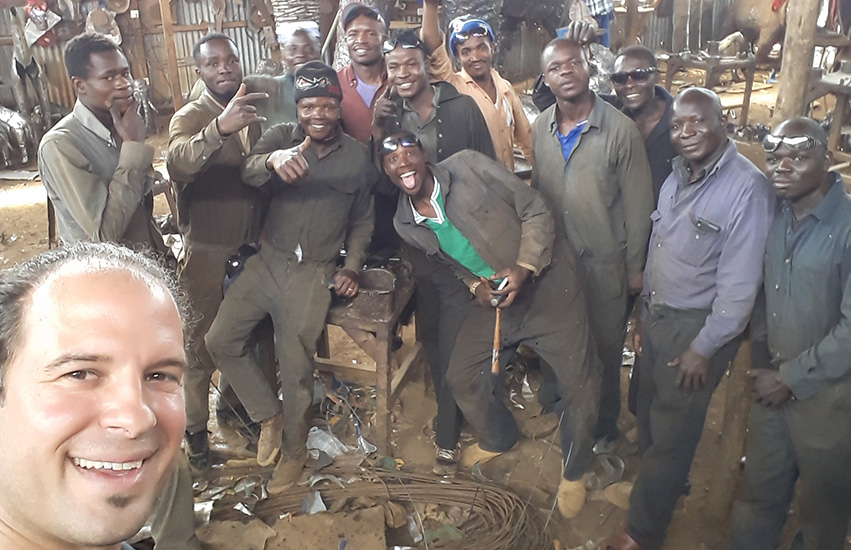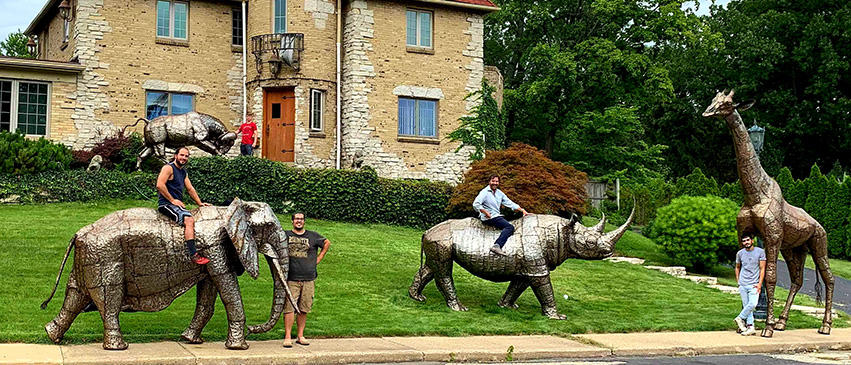Magnificent Creatures: Q&A with Monte de Gallo

Toward the end of last summer, an unusual mystery briefly consumed Peorians when a number of large, steel sculptures started popping up around town. A giraffe, an elephant, a rhinoceros, a bull… these magnificent, life-sized creatures seemed to appear out of nowhere. Eventually, word spread they were the work of Monte de Gallo—Peoria-based artist and P.T. Barnum-like showman, with a wardrobe as colorful as the man itself. And to thicken the plot of this mystery, “Monte” was not his real name.
Born Nicholas di Caro, the artist spent some of his early years in Sicily, graduated from Pekin Community High School, and later moved to California. After marrying a Kenyan woman, he traveled to her homeland and was doubly inspired: both by the animals he saw in the wild, and by the locals creating sculptures out of scrap metal. Combining the two, he soon developed an ambitious vision for an art production company that would design and manufacture thousands of steel animal sculptures. Working with sculptors across two continents, de Gallo is now raising funds to fulfill his vision of creating a Safari Art Park—a themed sculpture garden right here in Peoria. Peoria Magazine spoke with the artist about his background, the origins of his alter-ego, his future plans and much more.
What first inspired you to get into art? Describe some of your early artistic experiences.
I believe everyone is an artist first before anything else. Just look at children: they draw, they paint, they make things with the objects around them. It’s how they interpret the world. It’s how they create something from nothing. It’s the creator within, coming forth.
I liked drawing a lot when I was young: insects, landscapes, vicious animals, cartoons, mythical creatures, etc. I play the violin and have since I was five years old. I bought an electric violin as an adult and play some of my old Suzuki favorites with an amplified twist! I mostly play by ear, and I can mimic many tunes within just a few minutes of trying. I’ve also designed and built websites for the different entrepreneurial ideas I’ve had over the years—real estate wholesaling, text message marketing, automated daily inspirational message service, party crashers, mortgage trading, Sculptures By Monte, clothing design. I’ve designed (and wear) five custom suits, and I’ve made little trinkets and jewelry.
How did you first get into sculpture? Did you have training or a mentor?
No training, no mentor. I’m just a guy who is deathly afraid of leaving this world without leaving my mark. Whatever mark that might be, it must be positive; it must be bright. It must be a “Wow” for at least one person—preferably many! I’ve been studying the ultra-high-end market for art for more than a decade, seeing what gets purchased, by whom, from whom and for how much. And I thought, “That looks like fun” and “I can make that” so... “I’ve been having fun lately,” and “I’ve been making that!”

Why did you decide to create the alter-ego Monte de Gallo?
At first it had nothing to do with art (well, maybe performance art!). It was December 31, 2010. My friend and I had plans to attend a $300 black-tie event in Chicago for New Year’s Eve. My friend suggested we omit the boring black ties and formal wear and dress differently. We ultimately decided to dress in 1960s disco attire. We thought of alter-ego names on the spot... I thought of Monte de Gallo because it sounded a little like my real name, and Gallo means “rooster” in Italian (and Spanish), which is the sign of my birth. Monte means “mountain” in Italian (and Spanish). The events that soon proceeded would mean “the Mountain” (Monte) was staying around for a long time...
When my friend “Sebastian St. Clair” arrived with the flamboyant “Monte de Gallo” at this black-tie event, people lost their minds! We weren’t prepared for what was going to happen. We pranced around in these crazy outfits and acted like fun-loving celebrities. People started to form lines to take pictures with us; the spotlight ignored the band and DJ, and instead followed us around. A few “groupies” started to tag along... so I enlisted them as our “managers” and “bodyguards”... and they started to play the part—to keep people at bay, or allow them through! People started inviting us to their private parties, etc., etc.—too much to list here!
Sebastian and I have gone on to crash almost a dozen different parties over the years, and every time people behave the same way. The best story ever was how we had about two dozen police officers dancing and laughing their asses off and taking selfies with them on a cold Chicago night a few years later, while a crowd of about 100 people watched us interact with the police!
What distinguishes Nicholas from Monte?
The lines are definitely blurred. I think Monte is starting to take over! Monte is what every man wishes he could be. He is brave and courageous. Bold and unabashed. Yet he is suave and sophisticated with intellectual charm and grace, and hosts a great party! Nic is just a guy trying to figure things out the best he can. Monte was nothing more than a party crasher when he was born. Now he is evolving into a worldwide fashion luxury brand.
What initiated your travels to Africa in 2012?
I got married to a Kenyan woman in 2010, and we were on a three-week family trip. We went on a wildlife viewing safari and witnessed giraffes, buffalos, lions, rhinos and elephants in the wild—up close and personal!
Tell me about the artists you connected with there. How did you first meet up with them, and what did they teach you?
On that same trip, I witnessed how many people created ways to earn money. Some sold bananas to the passersby; some cooked “fast food” from a street grill; and many, many people created art from garbage—handmade shoes from old tires, wall art from bottlecaps thrown on the road, handbags from woven plastic shopping bags, and little sculptures from scrap metal. I talk to just about everyone, anywhere, and almost anytime. In Kenya, everyone speaks English… so it was very easy to connect with people.
I saw that many beautiful things can be created from repurposing garbage. They taught me that the conditions to create something beautiful are only limited by a person’s imagination. But I also recognized that a person’s imagination can be limited by their environment and economic situation. I saw how these things can be improved, refined and ultimately turned into a brand. I connected with a few metal artists and started molding their thoughts to think bigger and better, and over the years we have been inching towards the realization of this vision—bringing amazing works of art to the world that were once considered useless.

And do you still work with them today?
Yes, all of the same key people are still helping me with these amazing creations. We have become friends. I’ve been to Kenya over a dozen times now, but I worry I may have to wear a mask for the two ten-hour flights next time!
Describe the sculpting process itself. Is everything done by hand?
I made a YouTube video about this topic. Everything is done by hand. We first start with an idea, and a wire frame is created. This is key—if the frame is off, so will be the final product. Each frame comes out different. It’s not like baking a cake; it’s more like bending circles of wire and welding the wires to make the frame of a three-tiered cake. Then we literally start hand-cutting with tin snips, hand-held hammer pounding and welding as fast as possible, section by section. The haphazard process ensures that every piece is unique... although they don’t all “look good.” The ugly ones get dismantled and reworked. They are then shipped in pieces to my East Peoria workshop, where all of the final welding assembly and exterior finishing is completed. The only modern tools are electric metal grinders, electric welders, and an occasional spray gun for paint and clear coats. We have a variety of homemade anvils for shaping the metal into spheres or weird shapes.
How many people do you employ in this process?
Twelve people in Kenya and six in the Peoria area.
Your animal sculptures caused a splash when they started popping up around Peoria last year. How did that come about?
It was kind of by accident. I had been quietly producing them over the years and just showing them to family and friends. The BraziLionaires were going to play a concert at Pour Bros., and my friend Rico Wayne Johnson, singer-songwriter in the band, asked if I would display a few pieces at their concert. I contacted the owners of Pour Bros., and they gave me a green light. There must have been a miscommunication, because the day before the concert, I rented a giant U-Haul truck and lots of labor to set up the display, and they told me the property owners refused to allow the display for insurance reasons. I had all the sculptures ready and the labor, so I called a few people and asked if I could display the sculptures at their homes! Then I continued with the campaign of moving them around. My phone was ringing off the hook, and I made a few sales as well.
How can you fulfill the vision for your company—manufacturing thousands of large sculptures—without sacrificing the unique, personal touch?
There are lots and lots of talented people around the world who need jobs. Hopefully I can make this art production company profitable so we can continue producing and hiring art apprentices, craftspeople and welders to give them sustenance, meaning and purpose.
Tell me more about your day job in financial services/real estate. How does your work facilitate your art?
It’s a hard grind. It’s very competitive, with little room for innovation. I have developed skills in PR and marketing through this “job” and I hope to translate it into this art gig! Right now, it’s helping pay for all of the bills. I am grateful. A lot of people didn’t know it cost me about $6,000 to move the animal sculptures around to 11 different locations in five months last year. From renting the biggest U-Haul trucks available, to organizing and hiring five guys at a time, to dealing with “no-shows” and flat tires on the U-Haul trucks, to backing into someone’s car (That $6,000 doesn’t include how my car insurance was affected!), etc…

Tell us about your plans for the Safari Art Park. Why do you believe this is an important project for Peoria?
I have lived in many places and I have seen what makes cities thrive, and what causes cities to die. Peoria is on the cusp of growing into something great, or dying and becoming a wasteland. Cities that grow have attractions that draw tourists, new businesses, and then new jobs. People want to live and work in a safe city with beauty, services and amenities. Period. In these uncertain times, we need hope more than anything! People are more divided than ever. We just need to agree that we have differences, leave those aside, and instead walk together toward the goals that we share! I don’t think anyone would dispute having a unique and wonderful place to go and enjoy the day by yourself, or have fun with friends or family—for free—is a good thing! Common Unity = Community. I’m trying to bring hope back to my city in my own way. Bringing people together for a common goal—a unique attraction that encourages people to move here and continue living here.
Currently, I am raising funds to build the Safari Art Park—my GoFundMe page can be found at safariartpark.org. I am also exploring corporate sponsorships who would like to name the park and bring these sculptures to this area for generations. I envision the park growing and changing with new animal sculptures and exhibits every two years. Also, please contact me if you’d like to memorialize a loved one at the park through your sponsorship. PM
To learn more about Monte de Gallo’s artwork, visit sculpturesbymonte.com. Check out his vision for the Safari Art Park at safariartpark.org.
- Log in to post comments

